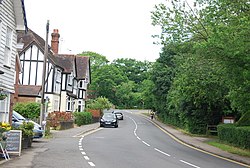Etchingham
| Etchingham | |
| Sussex | |
|---|---|

| |
| Location | |
| Grid reference: | TQ708259 |
| Location: | 51°0’27"N, -0°26’0"E |
| Data | |
| Population: | 864 (2019 est.) |
| Post town: | Etchingham |
| Postcode: | TN19 |
| Dialling code: | 01580 |
| Local Government | |
| Council: | Rother |
| Parliamentary constituency: |
Bexhill and Battle |
Etchingham is a village in Sussex, about fifteen miles south-east of Royal Tunbridge Wells, the latter mainly in Kent, and thirteen miles north-west of Hastings, on the A265, half a mile west of its junction with the A21.
The most notable sights in Etchingham are Etchingham railway station, Etchingham CofE primary school and its local amenities, such as a post office and butchers. The station is on the Hastings Line to London Charing Cross and Cannon Street.
Name
The name Etchingham is probably derived from Old English, apparently from Eccinga ham, meaning "Homestead or enclosure of Ecca's family and followers.
A second possible derivation of the name is that it could come from the Old English ecen, meaning 'increased' and ham (homestead), but the former explanation is the most likely.[1]
The church

The 14th-century parish church bears a remarkable dedication for a Protestant church: 'The Assumption of Blessed Mary and St Nicholas'. On its spire is what is probably England's oldest brass weathervane.
The church also has the second-largest series of misericords in the county;[2] one depicts a fox preaching to geese. Memorial brass to Agnes Oxenbridge and Elizabeth Etchingham is visible on the floor of the side aisle.
History
Long before the Norman conquest of 1066, Etchingham was a moated manor house; after this time the manor was taken over by the Normans. In 1166 it was left to the de Achyngham (Etchingham) family, who were well-known landowners of the time. The Etchingham family papers record that William was so pleased with the right-hand man that he gave him the land now known as Etchingham.
The manor, long since demolished, stood at the point now occupied by the London to Hastings railway line. Some of the stone from the manor was likely used in the construction of the station buildings. Legend of a great bell that lay at the bottom of the moat surrounding the church and manor is frequently recounted amongst locals and that it would never be seen until six yokes of white oxen were brought to drag it up. However centuries have passed by, the moat is long gone and no bell has surfaced.
The 14th-century church was originally built within the grounds of the manor; evidence of the moat can still be seen.
Village sign

The design of the village sign is based on the de Etchingham family coat of arms. A similar design is used for the parish council logo, the primary school badge and the church weathervane.
Cricket

Etchingham had an active cricket team in 1939, the Etchingham & Fontridge Cricket Club, but the start of Second World War brought play to an abrupt end. After the war, the cricket field was not brought back into use. In early 2006, a group of enthusiasts decided to revive the tradition.
The new club has in its possession several artefacts, minutes of meetings and games dating back to the 1920s when the club was known as the "Etchingham & Fontridge Cricket Club". Keen to maintain a link with the original club, the new club uses the same name.
The original club was formed by Mr W. F. Foster, who later became its President. A pavilion was erected in 1920, and as the number of playing members increased, a 2nd eleven was formed. Records show that Colonel Hornblower was elected chairman in 1934, with Mr H. H. Howard as Secretary. By 1934 Mr J. Gorwyn had become Captain of the 1st team.
The newly reinstated club uses the previous club name to maintain a link with tradition. It is pleased that Lionel Dengate, who was secretary to the club in the 1930s agreed to serve as Honorary Club President.
The club does not yet have a suitable cricket field in the village, so for the time being all matches have to be away fixtures.
Outside links
| ("Wikimedia Commons" has material about Etchingham) |
References
- 'Etchingham, Past and Present' (Hurst Green Historical Society, 1994)
- 'Etchingham Parish Church Guide' (1983, revised 1994), compiled by Ilse M. Baker BA
- 'Hidden Sussex' & 'People of Hidden Sussex', Warden Swinfen & David Arscott
- Saul, Nigel (1986). Scenes from Provincial Life: Knightly Families in Sussex, 1280–1400. Clarendon Press. pp. 140–60. ISBN 9780198200772.
